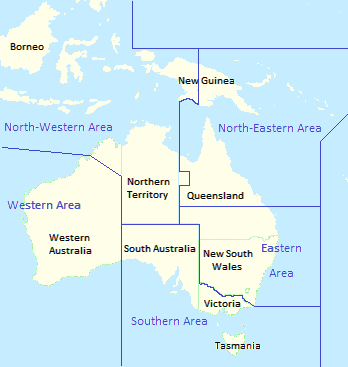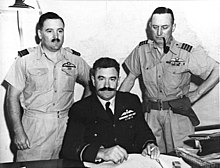| Northern Area Command | |
|---|---|
 RAAF area commands as at May 1942 | |
| Active | 1941–1942 |
| Allegiance | Australia |
| Branch | Royal Australian Air Force |
| Role |
Air defence Aerial reconnaissance Protection of adjacent sea lanes |
| Garrison/HQ | Townsville, Queensland |
| Engagements | World War II |
| Commanders | |
| Notable commanders | Frank Lukis (1941–42) |
Northern Area Command was one of several geographically based commands raised by the Royal Australian Air Force (RAAF) during World War II. It was formed in May 1941, and covered the whole of northern Australia and Papua New Guinea. Headquartered at Townsville, Queensland, Northern Area Command was primarily responsible for air defence, aerial reconnaissance and protection of the sea lanes within its boundaries. In January 1942, following the outbreak of the Pacific War, it was divided into North-Western and North-Eastern Area Commands, to counter Japanese threats to northern Australia and Papua, respectively.
History[]
World War II[]

Air Commodore Lukis (centre), who served as Air Officer Commanding Northern Area throughout its existence, with Group Captains Bill Garing (left) and Harry Cobby in Townsville, Queensland
Between March 1940 and May 1941, the Royal Australian Air Force (RAAF) divided Australia and New Guinea into four geographically based command-and-control zones: Central Area, Southern Area, Western Area, and Northern Area.[1] The roles of these area commands were air defence, protection of adjacent sea lanes, and aerial reconnaissance. Each was led by an Air Officer Commanding (AOC) responsible for the administration and operations of all air bases and units within his boundary.[1][2]
Northern Area Command, headquartered in Townsville, Queensland, was formed on 8 May 1941 under the leadership of Air Commodore Frank Lukis. The command covered northern New South Wales, Queensland, the Northern Territory, and Papua New Guinea.[1] Lukis was thus responsible for air defence along the entire north coast of Australia.[3] The main air base in the Northern Territory, RAAF Station Darwin, was augmented by eight satellite bases in the region.[4] Between June and November 1941, Northern Area took the lead in tracking Japanese pearl luggers, whose increased presence off north-western Australia was regarded as "significant" by intelligence services.[5] Central Area was disbanded in August and its responsibilities divided between Northern Area, Southern Area, and the newly formed No. 2 Training Group.[6]

No. 11 Squadron Catalina at Port Moresby, 1941
By December 1941, Lukis' frontline strength in the Northern Territory consisted of No. 2 Squadron (flying Lockheed Hudsons), No. 12 Squadron (CAC Wirraways), and No. 13 Squadron (Hudsons), based at RAAF Station Darwin.[7] As the Pacific War broke out, Nos. 2 and 13 Squadrons deployed forces to advanced operational bases at Koepang, Laha and Namlea in the Dutch East Indies.[8] Nos. 11 and 20 Squadrons (flying PBY Catalinas) were based at Port Moresby in Papua New Guinea, and No. 24 Squadron (Hudsons and Wirraways) at Rabaul in New Britain.[9] Northern Area Command was instructed to "strike at Japanese bases or shipping wherever possible"; "obtain such warning as is possible of any attempted southward movements by the Japanese"; "keep open the shipping routes through the Coral, Arafura and Timor Seas"; and "deny enemy access to Rabaul and to the Territories of New Guinea, Papua and the Mainland of Australia".[7] Nos. 2, 11, 13, 20 and 24 Squadrons engaged in reconnaissance, maritime patrol and sporadic bombing missions against Japanese targets in the Dutch East Indies and Torres Strait.[10] Short of modern fighters and sufficient numbers of bombers, however, the RAAF units were, in the words of the official history of Australia in the war, "virtually powerless" to either attack or defend against Japanese forces building up in the region.[11]
On 15 January 1942, Northern Area was split into North-Western Area and North-Eastern Area, in an attempt to more effectively counter distinct Japanese threats to Ambon and Darwin in the former case, and Rabaul and Port Moresby in the latter.[12][13] Lukis remained at Townsville as AOC of the new North-Eastern Area Command.[3][14]
Legacy[]
Following the end of the war, the Chief of the Air Staff, Air Vice Marshal George Jones, proposed reducing the five extant mainland area commands (North-Western, North-Eastern, Eastern, Southern, and Western Areas) to three. One of these would have been Northern Area, covering Queensland and the Northern Territory. The Australian Government rejected the plan and the wartime area command boundaries essentially remained in place until supplanted in 1953–54 by a functionally based command-and-control system made up of Home (operational), Training, and Maintenance Commands.[15][16]
Notes[]
- ↑ 1.0 1.1 1.2 Gillison, Royal Australian Air Force, pp. 91–92
- ↑ "Organising for war: The RAAF air campaigns in the Pacific". October 2009. http://airpower.airforce.gov.au/Publications/Details/403/121-Organising-for-War-The-RAAF-Air-Campaigns-in-the-Pacific.aspx. Retrieved on 4 July 2013.
- ↑ 3.0 3.1 Stephens, The RAAF in the Southwest Pacific, pp. 37–38
- ↑ Gillison, Royal Australian Air Force, p. 126
- ↑ Gillison, Royal Australian Air Force, pp. 133–134
- ↑ Gillison, Royal Australian Air Force, p. 112
- ↑ 7.0 7.1 Helson, The Forgotten Air Force, pp. 57–60, 118
- ↑ Helson, The Forgotten Air Force, pp. 65–67
- ↑ Gillison, Royal Australian Air Force, pp. 237–238
- ↑ Gillison, Royal Australian Air Force, pp. 240–242
- ↑ Gillison, Royal Australian Air Force, pp. 319–322
- ↑ Stephens, The Royal Australian Air Force, pp. 111–112
- ↑ Gillison, Royal Australian Air Force, p. 311
- ↑ Ashworth, How Not to Run an Air Force, pp. 302–304
- ↑ Helson, The Private Air Marshal, pp. 321–325
- ↑ Stephens, Going Solo, p. 68
References[]
- Ashworth, Norman (2000). How Not to Run an Air Force! Volume 1 – Narrative. Canberra: RAAF Air Power Studies Centre. ISBN 0-642-26550-X. http://airpower.airforce.gov.au/Publications/Details/241/How-Not-To-Run-An-Air-Force-Volume-1.aspx.
- Gillison, Douglas (1962). Australia in the War of 1939–1945: Series Three (Air) Volume I – Royal Australian Air Force 1939–1942. Canberra: Australian War Memorial. OCLC 2000369. http://www.awm.gov.au/histories/second_world_war/volume.asp?levelID=67912.
- Helson, Peter (1997). The Forgotten Air Force: The Establishment and Employment of Australian Air Power in the North-Western Area, 1941–1945 (Masters). Australian Defence Force Academy. OCLC 224054611. http://handle.unsw.edu.au/1959.4/38719.
- Helson, Peter (2010). The Private Air Marshal. Canberra: Air Power Development Centre. ISBN 978-1-920800-50-5. http://airpower.airforce.gov.au/Publications/Details/425/The-Private-Air-Marshal.aspx.
- Stephens, Alan (ed.) (1993). The RAAF in the Southwest Pacific Area 1942–1945. Canberra: RAAF Air Power Studies Centre. ISBN 0-642-19827-6. http://airpower.airforce.gov.au/Publications/Details/200/RAAF-History-Conference-1993-The-RAAF-in-the-SouthWest-Pacific-Area.aspx.
- Stephens, Alan (1995). Going Solo: The Royal Australian Air Force 1946–1971. Canberra: Australian Government Publishing Service. ISBN 0-644-42803-1.
- Stephens, Alan (2006) [2001]. The Royal Australian Air Force: A History. London: Oxford University Press. ISBN 0-19-555541-4.
The original article can be found at Northern Area Command (RAAF) and the edit history here.